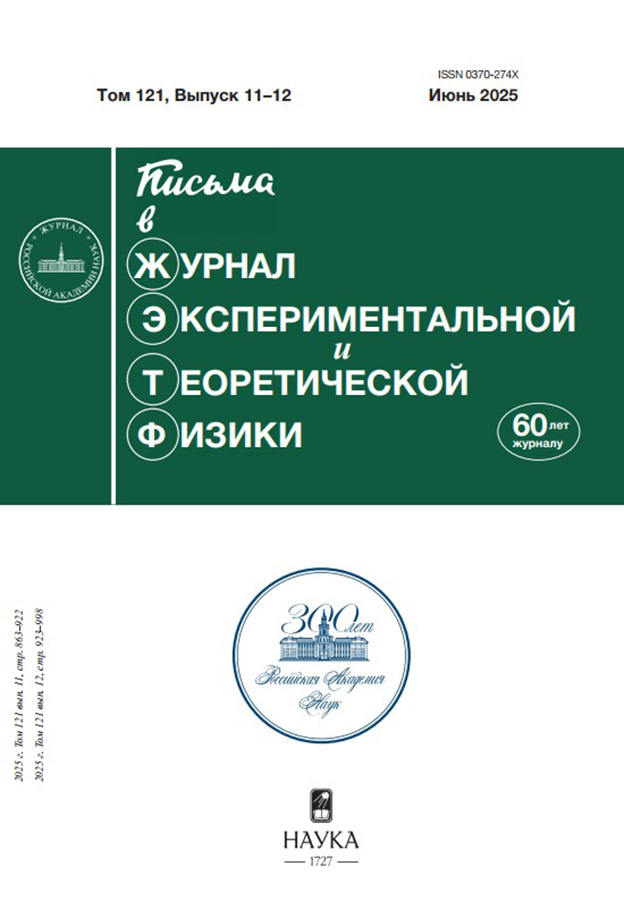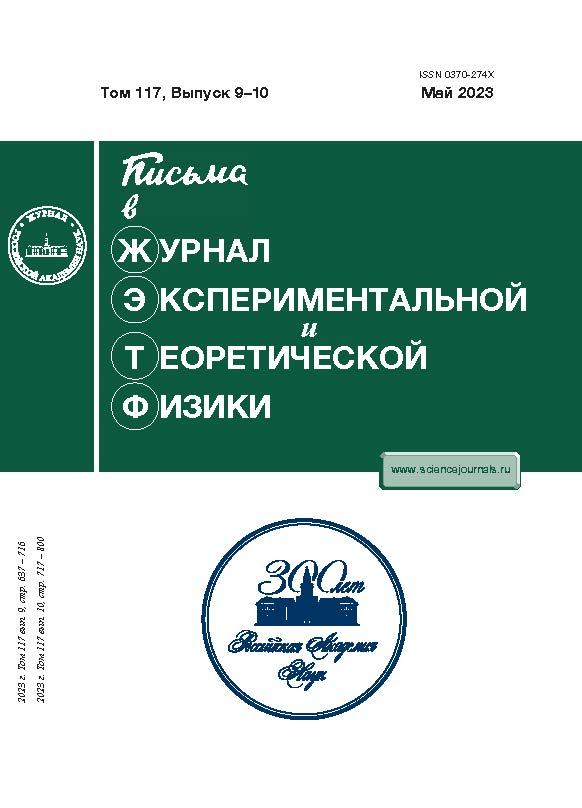Tilt and Anisotropy of the Dirac Spectrum Caused by the Overlapping of Bloch Functions
- Authors: Alisultanov Z.Z1,2, Demirov N.A3
-
Affiliations:
- Abrikosov International Center for Theoretical Physics, Moscow Institute of Physics and Technology (National Research University), 141701, Dolgoprudnyi, Moscow region, Russia
- Institute of Physics, Dagestan Scientific Center, Russian Academy of Sciences, 367015, Makhachkala, Russia
- Joint Institute for High Temperatures, Russian Academy of Sciences, 125412, Moscow, Russia
- Issue: Vol 117, No 9-10 (5) (2023)
- Pages: 777-782
- Section: Articles
- URL: https://rjonco.com/0370-274X/article/view/662561
- DOI: https://doi.org/10.31857/S1234567823100105
- EDN: https://elibrary.ru/CNSJBG
- ID: 662561
Cite item
Abstract
It has been shown that the overlapping of bands belonging to equivalent representation of the symmetry group is possible in systems with Dirac points appearing at the crossing of these bands. This overlapping results in the tilt and additional anisotropy of the Dirac spectrum, as well as in the renormalization of the velocity. At the same time, overlapping does not violate the general conditions of existence of the stable band crossing point. The effective Dirac Hamiltonian in the presence of band overlapping is pseudo-Hermitian and corresponds to the effective action of a massless spinor field in the curved spacetime.
About the authors
Z. Z Alisultanov
Abrikosov International Center for Theoretical Physics, Moscow Institute of Physics and Technology (National Research University), 141701, Dolgoprudnyi, Moscow region, Russia; Institute of Physics, Dagestan Scientific Center, Russian Academy of Sciences, 367015, Makhachkala, Russia
Email: zaur0102@gmail.com
N. A Demirov
Joint Institute for High Temperatures, Russian Academy of Sciences, 125412, Moscow, Russia
Author for correspondence.
Email: zaur0102@gmail.com
References
- N. P. Armitage, E. J. Mele, and A. Vishwanath, Rev. Mod. Phys. 90, 015001 (2018).
- P. A. Dirac, Proceedings of the Royal Society of London A: Mathematical, Physical and Engineering Sciences 117, 610 (1928).
- H. Weyl, Proc. Natl. Acad. Sci. USA 15(4), 323 (1929).
- S. Murakami, New J. Phys. 9(9), 356 (2007).
- S. Murakami, S. Iso, Y. Avishai, M. Onoda, and N. Nagaosa, Phys. Rev. B 76, 205304 (2007).
- M. Katsnelson, Graphene: Carbon in Two Dimensions, Cambridge University Press, Cambridge (2012).
- E. Kogan and V. U. Nazarov, Phys. Rev. B 85, 115418 (2012).
- B. Bradlyn, J. Cano, Z. Wang, M. Vergniory, C. Felser, R. Cava, and B. A. Bernevig, Science 353, aaf5037 (2016).
- A. A. Soluyanov, D. Gresch, Z. Wang, Q. Wu, M. Troyer, X. Dai, and B. A. Bernevig, Nature 527(7579), 495 (2015).
- B. J. Wieder, Y. Kim, A. M. Rappe, and C. L. Kane, Phys. Rev. Lett. 116, 186402 (2016).
- З. З. Алисултанов, ЖЭТФ 152(5), 986 (2017).
- З. З. Алисултанов, Письма в ЖЭТФ 107(4), 260 (2018).
- C. Herring, Phys. Rev. 52, 365 (1937).
- E. Antoncık and P. T. Landsberg, Proc. Phys. Soc. 82, 337342 (1963).
- V. Halpern, J. Phys. Chem. Solids 24, 14951502 (1963).
- N. Bernstein, M. J. Mehl, and D. A. Papaconstantopoulos, Phys. Rev. B 66, 075212 (2002).
- W. A. Harrison and S. Ciraci, Phys. Rev. B 10, 1516 (1974).
- J. Tejeda and N. J. Shevchik, Phys. Rev. B 13, 2548 (1976).
- T. B. Boykin, P. Sarangapani, and G. Klimeck, J. Appl. Phys. 125, 144302 (2019).
- C. Herring, Phys. Rev. 52, 361 (1937).
- C. Kittel, Quantum Theory of Solids, Wiley, N.Y. (1963).
- A. Mostafazadeh, J. Math. Phys. 43, 205214 (2002).
- A. Mostafazadeh, J. Math. Phys. 43, 28142816 (2002).
- A. Mostafazadeh, J. Math. Phys. 43, 39443951 (2002).
- Z. Z. Alisultanov and E. G. Idrisov, Phys. Rev. B 107, 085135 (2023).
- J. Nissinen and G. E. Volovik, JETP Lett. 105, 442 (2017).
- J. Nissinen and G. E. Volovik, JETP 127, 948957 (2018).
- G. E. Volovik, Black hole and Hawking radiation by type-II Weyl fermions, JETP Lett. 104, 645 (2016), arXiv:1610.00521
- Y. Kedem, E. J. Bergholtz, and F. Wilczek, Phys. Rev. Research 2, 043285 (2020).
- I. Proskurin, M. Ogata, and Y. Suzumura, Phys. Rev. B 91, 195413 (2015).
- M. Mili'cevi'c, G. Montambaux, T. Ozawa, O. Jamadi, B. Real, I. Sagnes, A. Lemaˆıtre, L. Le Gratiet, A. Harouri, J. Bloch, and A. Amo Phys. Rev. X 9, 031010 (2019).
- A. Wild, E. Mariani, and M. E. Portnoi, Phys. Rev. B 105, 205306 (2022).
- Y. Yekta, H. Hadipour, and S. A. Jafari, Commun. Phys. 6, 46 (2023).
Supplementary files











